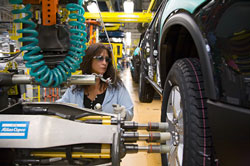Changing the Auto Industry from the Wheels Up
The problems of the U.S. auto industry call for radical solutions.
This is a web-only article from the website of Dollars & Sense: The Magazine of Economic Justice available at http://www.dollarsandsense.org

This is a web-only article, available only at www.dollarsandsense.org.
Subscribe Now
at a 30% discount.
Intro | Pt. I | Pt. II | Pt. III | Pt. IV | Pt. V | Pt. VI | Full article

Photo by Jim West
Part I: Were Bailouts Necessary?
The government did not have to bail out the auto companies in order to keep workers employed and producing something (whether cars or something else).
In his testimony before the Senate banking committee in November, then-GM Chairman Rick Wagoner offered an apocalyptic vision of what would happen “if the domestic industry were allowed to fail” (that is, if the government did not cough up the bailout GM and Chrysler were requesting): “The societal costs would be catastrophic: three million jobs lost within the first year, U.S. personal income reduced by $150 billion, and a government tax loss of more than $156 billion over three years… not to mention the broader blow to consumer and business confidence.” [Note 23]
The figures, also cited by Chrysler Chairman Robert Nardelli, [Note 24] come from a November report by the Center for Automotive Research (CAR) predicting the consequences of “the Detroit Three automakers ceasing all operations in United States.” Wagoner and Nardelli obviously chose this “100 percent contraction scenario” to make the consequences of refusing a bailout seem as bad as possible. This scenario is extremely pessimistic, assuming the disappearance of GM and Chrysler, the disappearance of Ford, which did not even ask for a bailout, and a temporary (one-year) disappearance of all U.S. auto production by international auto companies. [Note 25] More importantly, however, the auto CEOs’ pleas snuck in the false assumption that the only way to avoid this nightmare was for the government to bail out the companies.
The current administration appears to be determined to save GM and Chrysler in one way or another. “We cannot, and must not, and we will not let our auto industry simply vanish,” President Obama declared. [Note 26] If the companies ceased to exist, however, the workers would not vanish. The factory buildings and machinery would not vanish. If the government wanted to keep the workers employed and producing goods (whether cars or something else), it could pay the workers their wages and benefits, buy or build factories and machinery, and pay for other necessary inputs, such as materials and energy. If the government wanted to keep the workers producing cars, it could buy the auto companies themselves, or it could buy the factories and equipment (and allow the companies to cease to exist). If it wanted to put those workers to work producing something else, it could buy the factories and machinery and re-tool them as needed, or it could construct new factories or equipment (if the existing production apparatus proved unsuitable to the new purpose, or too costly to re-tool). Maintaining employment and production, in short, would not require preserving the companies in anything like their present form.
Not only were the bailouts unnecessary for saving the jobs of workers at GM and Chrysler or other companies (such as suppliers and dealers) affected by the crisis, but they have not succeeded in doing so. Auto industry employment in the United States (including vehicle and parts manufacturing and sales) has declined by about 400,000 jobs in the last year. [Note 27] In fact, maintenance of employment does not appear to have been the objective of government policy (under either Bush or Obama). The government has encouraged layoffs by requiring deep cuts in company costs as a condition of the bailout. The companies have sought concessions on past obligations from workers and bondholders, concessions on future wages and benefits from workers, and massive layoffs. Under GM’s government-mandated restructuring plan (after the first round of bailouts), the company promised to lay off 47,000 workers worldwide by the end of 2009. [Note 28] Chrysler’s plan promised to cut 35,000. [Note 29] The Obama administration rejected both plans as inadequate, saying that viable restructuring plans for both companies would require deeper cost cutting. [Note 30]
Intro | Pt. I | Pt. II | Pt. III | Pt. IV | Pt. V | Pt. VI | Full article
End Notes:
23. Prepared testimony by Rick Wagoner, Chairman and Chief Executive Officer, General Motors Corporation, to the United States Senate Banking, Housing, and Urban Affairs Committee, Washington, D.C., November 18, 2008, Wall Street Journal.
24. Chrysler CEO Bob Nardelli’s Testimony Transcript, November 18, 2008.
25. David Cole, Sean McAlinden, Kristin Dziczek, Debra Maranger Menk, CAR Research Memorandum: The Impact on the U.S. Economy of a Major Contraction of the Detroit Three Automakers, Center for Automotive Research (CAR), November 4, 2008.
26. Remarks by the President on the American Automotive Industry, The White House, Office of the Press Secretary, March 30, 2009.
27. Automotive Industry: Employment, Earnings, and Hours, Bureau of Labor Statistics.
28. General Motors Corporation, 2009-2014 Restructuring Plan, February 17, 2009.
29. Chrysler Restructuring Plan for Long-Term Viability, February 17, 2009.
30. Remarks by the President on the American Automotive Industry, The White House, Office of the Press Secretary, March 30, 2009.
Did you find this article useful? Please consider supporting our work by donating or subscribing.
